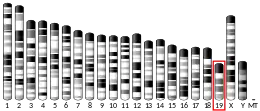GPHA2
Glycoprotein hormone alpha-2 is a protein that in humans is encoded by the GPHA2 gene.[5][6]
| GPHA2 | |||||||||||||||||||||||||||||||||||||||||||||||||||
|---|---|---|---|---|---|---|---|---|---|---|---|---|---|---|---|---|---|---|---|---|---|---|---|---|---|---|---|---|---|---|---|---|---|---|---|---|---|---|---|---|---|---|---|---|---|---|---|---|---|---|---|
| Identifiers | |||||||||||||||||||||||||||||||||||||||||||||||||||
| Aliases | GPHA2, A2, GPA2, ZSIG51, glycoprotein hormone alpha 2, glycoprotein hormone subunit alpha 2 | ||||||||||||||||||||||||||||||||||||||||||||||||||
| External IDs | OMIM: 609651 MGI: 2156541 HomoloGene: 15605 GeneCards: GPHA2 | ||||||||||||||||||||||||||||||||||||||||||||||||||
| |||||||||||||||||||||||||||||||||||||||||||||||||||
| |||||||||||||||||||||||||||||||||||||||||||||||||||
| |||||||||||||||||||||||||||||||||||||||||||||||||||
| |||||||||||||||||||||||||||||||||||||||||||||||||||
| |||||||||||||||||||||||||||||||||||||||||||||||||||
| Wikidata | |||||||||||||||||||||||||||||||||||||||||||||||||||
| |||||||||||||||||||||||||||||||||||||||||||||||||||
GPHA2 is a cystine knot-forming polypeptide and a subunit of the dimeric glycoprotein hormone family (Hsu et al., 2002).[supplied by OMIM][6]
References
- GRCh38: Ensembl release 89: ENSG00000149735 - Ensembl, May 2017
- GRCm38: Ensembl release 89: ENSMUSG00000024784 - Ensembl, May 2017
- "Human PubMed Reference:". National Center for Biotechnology Information, U.S. National Library of Medicine.
- "Mouse PubMed Reference:". National Center for Biotechnology Information, U.S. National Library of Medicine.
- Hsu SY, Nakabayashi K, Nishi S, Kumagai J, Kudo M, Sherwood OD, Hsueh AJ (Jan 2002). "Activation of orphan receptors by the hormone relaxin". Science. 295 (5555): 671–4. Bibcode:2002Sci...295..671H. doi:10.1126/science.1065654. PMID 11809971. S2CID 32693420.
- "Entrez Gene: GPHA2 glycoprotein hormone alpha 2".
7. Z. Gong, W. Wang, K. El Omari, A. A. Lebedev, O. B. Clarke, W. A. Hendrickson, Crystal structure of LGR ligand alpha2/beta5 from Caenorhabditis elegans with implications for the evolution of glycoprotein hormones. Proc Natl Acad Sci U S A 120 (1), e2218630120 (2023). https://www.pnas.org/doi/10.1073/pnas.2218630120#
Further reading
- Suzuki C, Nagasaki H, Okajima Y, et al. (2007). "The LIM domain homeobox gene isl-1 is a positive regulator of glycoprotein alpha 2 (GPA2), a subunit of thyrostimulin". Regul. Pept. 142 (1–2): 60–7. doi:10.1016/j.regpep.2007.01.009. PMID 17363077. S2CID 24382046.
- Breous E, Wenzel A, Loos U (2006). "Promoter cloning and characterisation of the transcriptional regulation of the human thyrostimulin A2 subunit". Mol. Cell. Endocrinol. 245 (1–2): 169–80. doi:10.1016/j.mce.2005.11.009. PMID 16376481. S2CID 21211666.
- Sudo S, Kuwabara Y, Park JI, et al. (2005). "Heterodimeric fly glycoprotein hormone-alpha2 (GPA2) and glycoprotein hormone-beta5 (GPB5) activate fly leucine-rich repeat-containing G protein-coupled receptor-1 (DLGR1) and stimulation of human thyrotropin receptors by chimeric fly GPA2 and human GPB5". Endocrinology. 146 (8): 3596–604. doi:10.1210/en.2005-0317. PMID 15890769.
- Gerhard DS, Wagner L, Feingold EA, et al. (2004). "The status, quality, and expansion of the NIH full-length cDNA project: the Mammalian Gene Collection (MGC)". Genome Res. 14 (10B): 2121–7. doi:10.1101/gr.2596504. PMC 528928. PMID 15489334.
- Strausberg RL, Feingold EA, Grouse LH, et al. (2003). "Generation and initial analysis of more than 15,000 full-length human and mouse cDNA sequences". Proc. Natl. Acad. Sci. U.S.A. 99 (26): 16899–903. Bibcode:2002PNAS...9916899M. doi:10.1073/pnas.242603899. PMC 139241. PMID 12477932.
- Hsu SY, Nakabayashi K, Bhalla A (2003). "Evolution of glycoprotein hormone subunit genes in bilateral metazoa: identification of two novel human glycoprotein hormone subunit family genes, GPA2 and GPB5". Mol. Endocrinol. 16 (7): 1538–51. doi:10.1210/mend.16.7.0871. PMID 12089349.
- Nakabayashi K, Matsumi H, Bhalla A, et al. (2002). "Thyrostimulin, a heterodimer of two new human glycoprotein hormone subunits, activates the thyroid-stimulating hormone receptor". J. Clin. Invest. 109 (11): 1445–52. doi:10.1172/JCI14340. PMC 150994. PMID 12045258.
This article is issued from Wikipedia. The text is licensed under Creative Commons - Attribution - Sharealike. Additional terms may apply for the media files.



